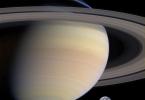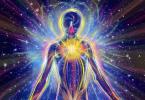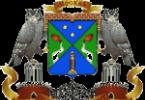Image of Saturn from the Cassini interplanetary station
1. Saturn is the second largest planet in the world after. This planet was named after the Roman god of agriculture.
2. Saturn is a type of gas planet: it consists mainly of gases and does not have a solid surface. This planet is mainly composed of hydrogen, with admixtures of helium and traces of water, methane, ammonia and heavy elements.

Saturn and Earth (photomontage)
3. The planet's mass is more than 95 times that of . However, Saturn's average density is only 0.687 g/cm3, making it the only planet in the Solar System whose average density is less than that of water.
4. The average distance between Saturn and is 1430 million kilometers. The average distance to Earth varies from 1195 to 1660 million kilometers.
5. Very strong winds blow on Saturn, the speed of which can reach 1800 km/h. This is much larger than Jupiter, which is home to the largest atmospheric vortex in the solar system, the Great Red Spot. The wind speed inside the spot is about 500 km/h.
6. There are 62 satellites orbiting Saturn, 53 of which have names. The largest of them, Titan, is superior in size and has the only dense atmosphere among the satellites of the planets of the Solar System. Its atmosphere is 1.5 times denser than Earth's.
7. Titan is the only body, besides the Earth, for which the stable existence of liquid on the surface has been proven. Scientists believe that the conditions on this satellite are similar to those that existed on our planet 4 billion years ago, when life was just beginning on Earth.

Hexagon on Saturn
8. Saturn is experiencing an unusual atmospheric phenomenon that has never been observed anywhere else in the solar system. The clouds at the north pole of this planet form a giant hexagon, which, according to the theory, is a vortex. The dimensions of this hexagon are so vast that four Earths could fit inside it.
9. The mass of Saturn's core is approximately 9 to 22 Earth masses.
10. All four gas giants have rings (Jupiter, Saturn, and), but Saturn has the most prominent ones. These rings, consisting mainly of ice, are very thin - with a diameter of about 250,000 kilometers, they are less than a kilometer thick.
11. A year on Saturn lasts 29 Earth years or 10,759 days.
12. The first spacecraft to fly past Saturn was Pioneer 11. It was launched in 1973, and in 1979, Pioneer 11 flew near this planet for the first time in history.

Saturn's moons and rings
13. The size of the particles of material that make up Saturn's rings very rarely reaches several meters. In general, the size of these particles varies from ≈ 0.001 mm to several centimeters.
14. Saturn's atmosphere consists mainly of hydrogen and helium.
15. Twice every 29 years, Saturn’s rings are not visible at all when observed from Earth—the human eye sees only the “edge” of the rings, which can barely be seen with a powerful telescope.
16. Saturn is 9 times wider than the Earth - its radius is 58.232 kilometers.
17. The interplanetary station Voyager 1, whose tasks included the study of Jupiter and Saturn, is currently the most distant object from Earth created by man.
18. A day on Saturn lasts only 10.3 hours.
19. About once every 30 years, a super-powerful hurricane known as the Great White Spot appears on Saturn. This atmospheric formation, reaching a size of several thousand kilometers, can be seen through a telescope from Earth by its characteristic appearance in white.
20. In 2008, the cameras of the interplanetary station "" received images of the north pole of Saturn, on which astronomers discovered the likes of which had never been observed in the Solar System. They are a new type of aurora that forms a ring around one of the planet's poles.

The small dot is Earth as seen from Saturn's orbit. Image from the Cassini interplanetary station, 2013
Its orbit lies 9.5 times further from the star than the Earth. Very interesting and interesting facts about Saturn are associated with its famous rings. Astronomers have discovered similar origins and natures of formation on other planets in our cosmic region: Neptune. However, they are significantly inferior in massiveness, density, and brightness to the rings of the sixth planet. However, interesting facts about Saturn are not only connected with them. This world is full of many others
Interesting facts about the planet Saturn
This celestial body is the third in size and mass in the solar system, second only to Jupiter and, of course, the Sun. The interesting thing is that this planet has the lowest density in the entire star system. The density of Saturn is 0.687 g/cm3. This is lower than that of water. Saturn is not at all like a rocky body, like our native Earth, Venus or Mars. The planet is composed primarily of hydrogen (which is the lightest naturally occurring element), as well as helium, methane, and a small amount of rock and ice concentrated in the planet's core. It is impossible to land on its surface. That's why scientists call it a "gas giant." Some interesting facts about Saturn arise from its surprisingly fast rotation. The planet spins so fast that it literally flattens itself at the poles. Therefore it has a noticeably flattened shape. Another side effect of the rotation is that it contains some of the most powerful winds in the solar system. Sometimes their speed reaches a monstrous 1800 km/h.

Interesting facts about Saturn and its rings
The rings are systems of concentric flat formations consisting of dust and ice. Actually, water ice is their main component. The size of these particles can range from tiny pebbles of a few micrometers to blocks of several meters. These formations can reach thousands and tens of thousands of kilometers in width (there are only three large ones, but in fact there are many more of them). It is all the more surprising that the thickness of the rings varies literally within one kilometer. And some disks even reach a thickness of 10-15 meters. The first scientist to observe these bodies near Saturn was Galileo Galilei. However, he was able to see them only on the sides of the planet and mistook them for satellites. The true nature of the phenomenon was discovered by the German Christian Huygens. By the way, there is an opinion in the scientific community that the Earth could have had similar rings about four billion years ago. Over time, under the influence of gravitational forces, they gathered into a single body, gradually forming our natural satellite, which today can be observed in the sky every night.

Interesting facts about Saturn and its moons
This huge planet also has satellites. And more than any other in the solar system. To date, 62 satellites of this planet have been discovered. Some of them are no less amazing than Saturn himself. For example, Encellus, composed almost entirely of ice and snow, has an extremely white surface and the highest albedo in our entire star system. It reflects almost all the light falling on it. It is very curious to scientists because its composition and atmosphere could potentially be suitable for the most primitive forms of life. The possibility of microorganisms being found there is seriously discussed in the scientific community.
What comes to mind first when we talk about the planet Saturn? The fact that it has rings, is very distant, next to Jupiter. This is done in elementary school, if not earlier. You can remember that Saturn is a gas giant and that it is the last planet in the solar system visible to the naked eye. 
What else do we know about Saturn? It is very cold there. And it does not have a solid surface, since it belongs to the gas giants.
Saturn with rings! But this has already been said...
It’s hard to remember anything else, more specific, offhand. Let's draw a portrait of this truly distant and at the same time close, cold and mysterious planet.
People first learned about Saturn's rings in 1610
Or rather, it was not yet known that the strange rounded protrusions that I saw Galileo Galilei into your telescope, they are shaped like rings. Progressive for that time, but extremely imperfect by our standards, the telescope made it possible to see only two blurred edges of the rings, similar to the ears of a saucepan. Galileo himself believed that he saw two satellites, or two “Moons” of Saturn. 
It was possible to clarify things only 45 years later. In 1655, Christian Huygens looked through a more accurate, improved telescope. He was the first to call the unusual protrusions rings. He also discovered the largest satellite of Saturn, which a little later was given the name Titan.
People took the first close-up photographs of Saturn in 1979
The first spacecraft that managed to take photographs of Saturn was Pioneer 11 in 1979. Since then, “guests” have visited the planet three more times: in 1980, 1981 and 2004. The last visit turned out to be the most fruitful: high-quality images made it possible to obtain a lot of new scientific data, including on the structure of the rings. 
Planet Saturn is lighter than water
Indeed, this gas giant, which contains a lot of helium, has a very low density. The age of Saturn's rings varies, as proven by the latest research.

Sometimes the rings disappear. At least at first glance
Why do Saturn's rings sometimes become invisible? Of course, they don't disappear anywhere. Only their perspective changes, that is, the angle of inclination at which they are visible from the Earth. If you see the rings from the edges, they are really almost invisible. Try to look at the brim of a hat, such as a top hat, if it is strictly at eye level. Now tilt the cylinder several times, at different angles.
Is there life on Saturn's moon?

Enceladus is one of the largest moons of Saturn. In scientific circles it is famous for the geysers discovered. It contains liquid water, which means life is presumably possible.

Photographs of Saturn near its North Pole show the outline of a hexagon. It is not yet known what physical phenomena this figure corresponds to: scientists have not yet come to a consensus.
Saturn has about 200 moons

Of these, 62 have an exact orbit established, and fifty-three have been given names. In addition to relatively large celestial bodies - satellites, there are about 150 “small moons”.
The strongest wind blows on Saturn
The speed of the Saturnian wind reaches 1,800 km/h. For comparison, on Earth, the strongest wind recorded a speed of “only” 483 km/h.
Everything mentioned above refers to a planet - an astronomical object. But we can talk about Saturn from other points of view, in other areas - such as mythology, culture, linguistics.

A cruel god who devours his children
In Roman mythology, the god Saturn was revered; in ancient Greek, the god Chronos (or Kronos) corresponded to him. In culture, the most famous plot is in which he devours his own children so that none of them deprive him of power. Many works of art are dedicated to this story. The most famous of them are a painting by Rubens and a fresco by F. Goya. 
The history of the creation of the fresco is dramatic: in his declining years, Francisco Goya, who had survived several serious illnesses, purchased a house near Madrid. The artist tried to solve painful internal problems by creating frescoes - paintings directly on the wall of the house, full of despair and horror. They were not intended for public viewing, and only after the artist's death were some of the works transferred to canvas.
One of the sculptures in the Summer Garden in St. Petersburg depicts Kronos, an evil old man, ready to sink his teeth into a baby.
- In astrological practice, Saturn correlates with the concept of time, as well as with situations that require all kinds of restrictions.
- In Chinese and Japanese, the name Saturn is interpreted as “Earth star”: it consists of two hieroglyphs with the meanings “earth” and “star”.
- Traditionally, each day of the week corresponded to one of the luminaries (Sun and Moon) or one of the visible planets. Saturn Day is Saturday, which is reflected in its name in many languages, especially European ones. Remember, for example, the English word Saturday.
- In medieval alchemy, Saturn corresponded to lead.
- The year of Saturn, or the period of its revolution around the Sun (as seen from Earth) is 29 years 165 days 11.68 hours.
- Saturn's rings formed at different times.
The universe is full of mysteries, as evidenced by interesting facts about the planet Saturn- a celestial body named after the long-time ruler of the Titans - Kronos.
- The planet's shape resembles an oblate ball. Saturn acquired this shape as a result of rapid rotation around its axis. A day here lasts only 10.7 hours. Due to such intense rotation, the planet flattens itself.
- The celestial body has a huge number of satellites (63). Scientists claim that some of them have the necessary conditions for life.

- Saturn has a developed system of rings, each of which has a bright and dark side. However, the inhabitants of the Earth have the opportunity to see exclusively the bright side. From our planet, the rings seem to disappear from time to time. This is due to the fact that only the edges of the rings are visible when tilted. According to modern theories, the rings were formed as a result of the destruction of Saturn's moons.

- If you imagine that the Sun is the size of a front door, then Saturn will resemble a basketball. In this case, the Earth will be the size of an ordinary coin.

- The planet is mainly composed of helium and hydrogen gases. It has almost no hard surface.

- If you put Saturn in water, it can float like a ball.. This is possible because the density of the planet is 2 times less than that of water.

- All rings have names that correspond to letters of the Latin alphabet. They received their names in the order in which they were discovered.

- Scientists around the world are actively studying Saturn. To this day, 5 missions have visited there. The first spacecraft visited this site in 1979. Since 2004, the study of the features of the celestial body has been carried out using a spacecraft called Cassini.

- 40% of all satellites in the Universe revolve around Saturn. Among them there are both regular and irregular satellites. The orbits of the first ones are quite close to the planet, the others are located far away. They were captured recently. The moon Phoebus is located farthest from the planet.

- Astronomers hypothesize that Saturn influenced the structure of the solar system. Due to the action of its gravity, the planet managed to throw Uranus and Neptune aside. However, for now this is just an assumption for which evidence needs to be found.

- The pressure of the atmosphere of the planet Saturn exceeds that of Earth by 3 million times. On this gas planet, hydrogen is compressed into a liquid and then a solid state. If a person gets there, he will immediately be flattened by atmospheric pressure.

- The planet is characterized by northern lights. It was captured by a spacecraft near the North Pole. A similar phenomenon could not be detected on any other planet.

- Bad weather is constantly raging on Saturn. A strong wind blows there, which at times turns into a hurricane. Local hurricanes are similar in their course to terrestrial ones. Only they appear much more often. During hurricanes, giant spots that resemble funnels form. They can be seen from space.

- Saturn is considered the most beautiful planet. The beauty of Saturn is ensured by the delicate blue color of the surface and bright rings. By the way, you can see this celestial body from Earth without any optical instruments. The brightest star in the sky is Saturn.

- The planet emits 2 times more energy than it receives from the Sun. Due to its remote location, very little solar energy reaches Saturn. It is 91 times less than what the Earth receives. At the bottom of the planet's clouds, the air temperature is only 150K. According to scientific hypotheses, the source of internal energy can be the energy released as a result of gravitational differentiation of helium.

The story about Saturn for children contains information about what the temperature is on Saturn, about its satellites and features. You can supplement your message about Saturn with interesting facts.
Brief message about Saturn
Saturn is the sixth planet of the solar system, which is also called the “lord of the rings”.
The planet got its name from the ancient Roman god of fertility. The planet has been known since ancient times, because Saturn is one of the brightest objects in our starry sky. It is the second largest giant planet. Saturn's rings, made up of thousands of solid pieces of rock and ice, orbit the planet at a speed of 10 km/s. Saturn's rings are very thin. With a diameter of about 250,000 km, their thickness does not reach even a kilometer.
There are 62 currently known satellites orbiting the planet. Titan is the largest of them, as well as the second largest satellite in the Solar System (after the satellite of Jupiter, Ganymede), which is larger than Mercury and has the only dense atmosphere among the satellites of the Solar System
Message about Saturn for children
The sixth planet, Saturn, was named after the Roman god of agriculture. Its dimensions are only slightly inferior to Jupiter.
The average diameter of Saturn is 58,000 km. Despite the large size, A day on Saturn lasts only 10 hours and 14 minutes.. One revolution around the Sun takes almost 30 Earth years.
The planet has 62 satellites discovered. Among them, the most famous are Atlas, Prometheus, Pandora, Epimetheus, Janus, Mimas, Enceladus, Tethys, Telesto, Calypso, Dione, Helen, Rhea, Titan, Hyperon, Iapetus, Phoebe. The satellite Phoebus, unlike all the others, turns in the opposite direction. In addition, the existence of 3 more satellites is assumed.
In terms of mass, Saturn is less than Jupiter by more than three times. The planet consists of gases, 94% of it is hydrogen, and the rest is mostly helium.
Due to this, wind speeds on Saturn are higher than on Jupiter - 1700 km/h. Moreover, wind flows in the southern and northern hemispheres of the planet are symmetrical relative to the equator.
Surface temperature of Saturn-188 degrees Celsius: This is the result of solar activity and its own heat source. In the center of the planet there is an iron-silicon core, with an admixture of ices from methane, ammonia and water, and the chemical lattice of ice inside Saturn is significantly different from the usual one.
Saturn is also unique because its density is less than the density of earthly water. This planet constantly experiences enormous storms, visible even from Earth, accompanied by lightning!
The most remarkable phenomenon of the cosmic god of time is considered to be the rings encircling the planet. They were discovered by Galileo in 1610. They orbit Saturn at varying speeds and are made up of thousands of solid pieces of rock and ice.
Saturn's rings are very thin. With a diameter of about 250,000 km, their thickness does not even reach a kilometer. Today astronomers It is known that there are 7 main rings.




